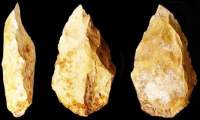The earliest stone toolmaking developed by at least 2.6 million years ago. The Early Stone Age includes the most basic stone toolkits made by early humans. The Early Stone Age in Africa is equivalent to what is called the Lower Paleolithic in Europe and Asia.
The oldest stone tools, known as the Oldowan toolkit, consist of at least:
• Hammerstones that show battering on their surfaces
• Stone cores that show a series of flake scars along one or more edges
• Sharp stone flakes that were struck from the cores and offer useful cutting edges, along with lots of debris from the process of percussion flaking
The invention of the flintlock gun mechanism in the sixteenth century produced a demand for specially shaped gunflints. The gunflint industry survived until the middle of the twentieth century in some places, including in the English town of Brandon.
For specialist purposes glass knives are still made and used today, particularly for cutting thin sections for electron microscopy in a technique known as microtomy. Freshly cut blades are always used since the sharpness of the edge is very great. These knives are made from high-quality manufactured glass, however, not from natural raw materials such as chert or obsidian. Surgical knives made from obsidian are still used in some delicate surgeries.
In archaeology, a tool stone is a type of stone that is used to manufacture stone tools. Alternatively, the term can be used to refer to stones used as the raw material for tools.








